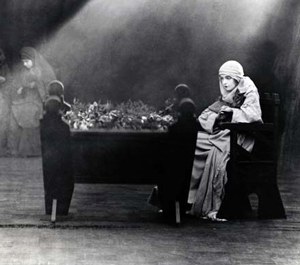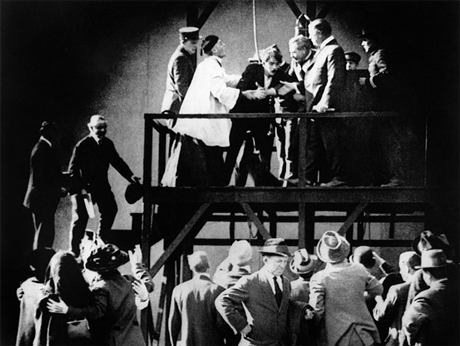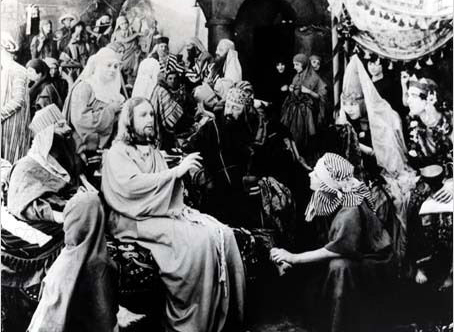Reviewed by Glenn Erickson
DVD and Blu-ray these days is seeing renewed interest in restorations of impressive silent classics, from Kino's Complete Metropolis to Paramount's Wings to Warner Home Video's recent, stunning The Big Parade. The Cohen Film Collection has already given us Douglas Fairbanks' The Thief of Bagdad this year, and it has now dug a decade deeper into the vaults for a stunning new restoration: D.W. Griffith's Intolerance: Love's Struggle Throughout the Ages , usually known as just Intolerance. Movies don't get any more legendary. Most of us have seen Griffith's epic in compromised prints that don't convey the quality of G.W. "Billy" Bitzer's cinematography.

After the incredibly successful, bitterly controversial Birth of a Nation, Griffith seized the opportunity to create an even more extravagant epic. He finished Mother and the Law, an impressive story of crime and injustice in the slums, but decided to use is as just one part of a multi-story super-epic, whose overarching theme would be the tragedy of intolerance throughout the ages. After the debacle over the Birth of a Nation's celebration of the Ku Klux Klan -- the film helped launch a revival of that vile organization -- Griffith played everything safe. Well, not quite safe: Intolerance's four separate narratives are not told consecutively in omnibus fashion, but are instead interwoven with each other. The action frequently jumps between stories, bridging centuries in a single cut.
The first narrative thread in Intolerance is the "Modern Story" adapted from Mother and the Law. We follow the hardships of a modern couple forced to move to the city after a cruel industrialist orders troops to fire on a labor demonstration. The Boy (Bobby Harron) falls in with a gangster. His wife the Dear One (Mae Marsh) is targeted by insufferable social 'Uplifters', who intercede to take away her baby. The Boy is sent to the gallows for a murder he did not commit, with the Dear One trying desperately to save him.
The second threat takes place in 1572. A case of straight religious persecution at the St. Bartholomew's Day Massacre, it shows the lead-up to a mass murder of Huguenots by French Catholics. Innocent young Brown Eyes (Margery Wilson) is a victim.
The third, Judean story depicts events in the life of the Christ (Howard Gaye), ending with the familiar events of the Passion.
The fourth narrative is an epic unto itself. In ancient Babylon, Prince Belshazzar (Alfred Paget) decides to permit religious freedom, and chooses as his own new deity Ishtar, the Goddess of Love. He prepares to marry his favorite, the fair and faithful Princess Beloved (Seena Owen). Meanwhile, for her mischievous behavior the fiesty Mountain Girl (Constance Talmadge) is sentenced to be sold into marriage. When Belshazzar grants the Mountain Girl her freedom, she pledges lifelong alliegance to him. Unknown to the Prince, the High Priest of Bel (Tully Marshall) is incensed that his power has been diminished by the open-faith ruling, and sells out Babylon to Cyrus the Great. Babylon turns back the Persian army through superhuman effort, but the High Priest arranges to open Babylon's giant gate for Cyrus, to permit a sneak attack. The mountain girl learns of the treachery and must race in a chariot to warn Belshazzar.

As a binding agent, Griffith repeatedly returns to a single image of the Eternal Mother (Lillian Gish) rocking a cradle. A title card from Walt Whitman is repeated as well: "Out of the cradle endlessly rocking." Almost like a static "thought" between gear changes, the image and its motto serve as a dramatic buffer and reminder of the timelessness of Griffith's theme.
Say what one will, the narrative structure in Intolerance is ambitous, original and audacious. The stories are not given equal emphasis. The historical dramas are dramatic extensions of the injustices suffered by the Boy and Dear One in the Modern Story, chosen to underline the theme of social intolerance. Griffith cuts between the parallel narratives at least fifty times, often comparing internal content. For instance, the bride auction and (rather racy) harem sequences in the Babylon story are an echo of scenes with the women in the dives of the Modern Story.
The most written-about aspect of Griffith's film is the way his four stories dovetail into a climactic cross-cutting final montage. The Dear One's car racing to stop the Boy's execution is intercut with The Mountain Girl's chariot as she hurries to warn of the Persian attack. The effect stacks melodrama onto melodrama. The historical stories all seem headed for grim ending. Will the Modern story also be a tragedy? 1

As might be expected, Intolerance is a mix of styles. Many interior shots are laid out like theater stages (but in greater depth) where the camera does not move. Then Griffith will turn around and give us dynamic shots taken from moving vehicles. It is said that Griffith cooked up the Babylon sequence as a conscious reaction to the Italian epic Cabiria. Griffith's enormous Babylon set far outdoes Pastrone, but outside of the still-impressive crane shots on the giant Babylon steps, the American director didn't feel comfortable moving his camera. We see only a few shots that truck with Belshazzar as he walks. The Modern Story has the same gritty slum atmosphere seen in Griffith's The Musketeers of Pig Alley, the better to suit the villainy of the Friendless One (Miriam Cooper), who frames the Boy for murder. By contrast, Griffith seems less interested in the French story, which is the film's least distinctive story thread. The Judean episode consists of static but beautifully rendered tableaux vivants of key stories from the New Testament. Billy Bitzer's lighting effects throw holy glows over parts of images. In one shot he superimposes a cross over the Jesus character.
Griffith goes whole hog with violent images in the Babylon battle, using break-apart dummies to show heads raggedly hacked off. Spears are plunged into screaming victims slowly, to insure that the audience won't miss the action. C.B. De Mille must have been impressed with the license shown in the harem sequence, which abounds with artful nudity.

Griffith's anti-intolerance theme allows him to climb atop a soapbox and rail against reformers and misguided do-gooders -- which was probably how he imagined groups protesting The Birth of a Nation. The Uplifters in the Modern Story are slammed as a pack of sexually frustrated, dried-up old maids. Their organization overcomes internal dissent to force their nasty will on the innocent Dear One. The picture does an injustice to the many benevolent reformers and social progressives of 1916. Given the appalling state of poverty in the big cities, I should think a lot of abandoned and abused children were in need of rescuing from unfit mothers; that reality hasn't changed all that much. Griffith's message of kindness and religious tolerance certainly transcends Hallmark Card sentimentality, but his argument is almost entirely emotional and simplistic. The sophistication is in the innovative cinematic technique, not the theme.
The film is very good at conjuring sentimental images with universal appeal. Murdering innocents and taking babies from their mothers are surefire ways to grab an audience. Christian viewers must have been deeply impressed by the vivid drama on the Via Dolorosa. I personally am a soft touch for almost any cinematic variation on Griffith's pacifist epilogue. As men fight hand to hand in a grim battle, the skies open up and angles descend from above. Both armies drop their weapons and rejoice. Who isn't ready for that to happen? Prisons evaporate and little kids kiss and play with posies in green fields -- who can object?
Intolerance is known for its enormous scope, its colossal sets, and how it was the biggest thing ever filmed perhaps until Gone with the Wind. They say the decaying set stood around in the middle of Hollywood for years, sticking up into the air behind a Sunset Blvd. intersection. Newer studies tell us that original audiences had no trouble understanding the multiple story structure. If Intolerance didn't make money, they say, it was because Griffith insisted on touring it with an expensive full orchestra, and that its pacifist message wasn't overwhelmingly popular in the run-up to WW1.

Cohen Film Collection's Blu-ray of Intolerance: Love's Struggle Throughout the Ages is a beautiful encoding of this impressive show. I was surprised by the high visual quality seen in the teaser trailer attached to the their disc of Les maudits. The shots are steady, sharp and detailed. Let's not forget clean; I'm used to seeing Intolerance jammed with dirt and marred frames, and these images almost always look immaculate. In the crane shots of the Babylon steps we can make out plenty of detail even when the view is fairly wide. Scenes end with clean Iris transitions. The repeated image of "the cradle, endlessly rocking" has smooth fade- ins and outs. The color tinting is even and consistent.
There are missing frames and tiny upcuts here and there, but they seem less obtrusive because the jumping of the splices have been removed. It's possible that Griffith experts will spot flaws or missing material I know nothing about, but the upshot is that this Intolerance far outclasses earlier presentations.
A second Blu-ray disc contains the extras plus two major bonuses, separate features made from two of the feature's stories. Mother and the Law was finally issued on its own as a single drama, and plays quite effectively. The Fall of Babylon likewise assembles the epic segment into one narrative thread. To make audiences happy, a partial "happy" ending was shot, to exploit the blooming stardom of actress Constance Talmadge.
Cohen's new teaser trailer is included, but the must-see extra is Kevin Brownlow's entertaining, informative lecture featurette. Brownlow adds special insights to the commonly known facts about the movie, and adds plenty of interesting personal detail. He has special praise for Carl Davis' orchestral score, which appears on this disc in 5.1 sound. An insert pamphlet contains essays by William M. Drew and Richard Porton.
On a scale of Excellent, Good, Fair, and Poor,
Intolerance: Love's Struggle Throughout the Ages Blu-ray rates:
Movie: Excellent
Video: Excellent
Sound: Excellent
Supplements: Trailer, Kevin Brownlow featurette, full features Mother and the Law and The Fall of Babylon.
Deaf and Hearing-impaired Friendly?
YES: All intertitles are in English
Packaging: Two Blu-ray discs and folder in keep case
Reviewed: November 3, 2013
Footnote:
1. Some thoughts about parallel editing in other movies. It has long been common for movies to inter-cut parallel storylines (as in, say, Soderbergh's Traffic. But it's rare for the stories to stack up so tightly at the conclusion, that a frenetic montage results. I'm sure Abel Gance does this several times, but most movies resolve separate plot threads one at a time.
The Boston Strangler and numerous thrillers by Brian De Palma attempt to show parallel storylines without cutting, via split-screen tricks. The horror classic Dead of Night contrives to have elements from all four of its ghost stories return in a frantic montage that mixes them up, as if in a blendor. The overarching "nightmare" theme comes through beautifully.
I know of one brilliant bit of cross-cutting between parallel actions that works by cheating on expectations. In Demme's The Silence of the Lambs an F.B.I. squad rushes to storm the hideout of the serial killer Buffalo Bill. Meanwhile, brave agent Starling (Jodie Foster) approaches Bill's hideout on her own. Through the conventions of parallel editing, we think that the F.B.I. will rescue Starling just in the nick of time -- but only when Buffalo Bill answers the door do we realize that the swat team and Starling are in different places altogether -- Bill's empty hideout is not the same as his present residence, where Starling is now in deadly peril. Demme's cut to a doorbell ringing like an alarm, is the point of "dreadful discovery."
Return

DVD Savant Text © Copyright 2013 Glenn Erickson
See more exclusive reviews on the Savant Main Page.
Reviews on the Savant main site have additional credits information and are often updated and annotated with reader input and graphics.
Also, don't forget the
2011 Savant Wish List.
T'was Ever Thus.
Return to Top of Page
|



